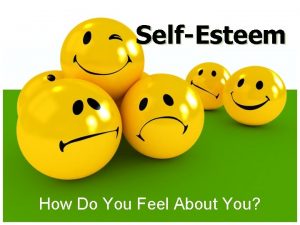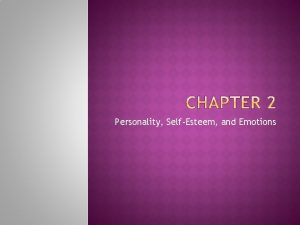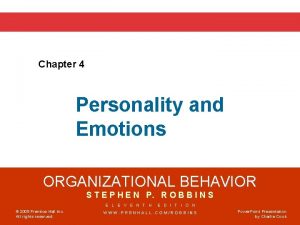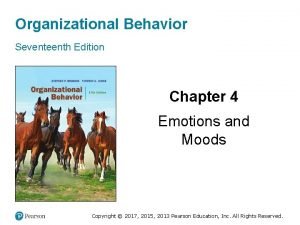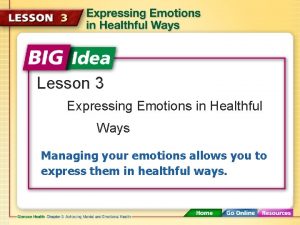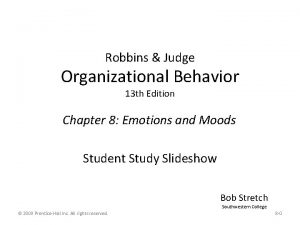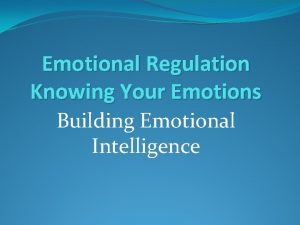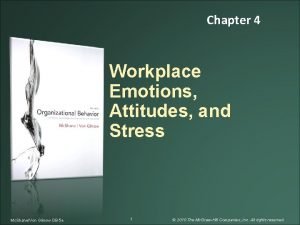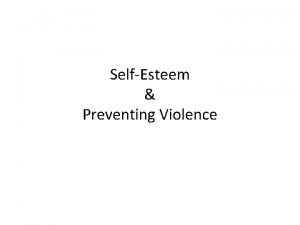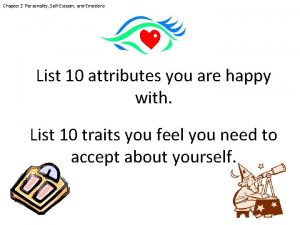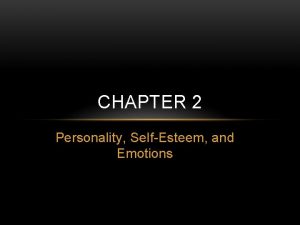Chapter 2 Personality SelfEsteem And Emotions Grade 7

















- Slides: 17

Chapter 2: Personality, Self-Esteem And Emotions Grade 7 Health Education Ms. Fitchwell

Personality and Mental Health: Describing Personality • PERSONALITY: the behaviors, attitudes, feelings, and ways of thinking that makes you an individual. • Psychologist: Studies how people think, feel, and behave. Ø How would you describe your own personality?

5 Traits to Describe Personality 1. Extrovert: friendly, outgoing – INTROVERT: person whose thoughts and feelings are directed inward 2. Agreeableness: Agree with others in a friendly way. Usually forgiving and good-natured 3. Conscientiousness: How responsible and self disciplined you are 4. Emotional Stability: Relaxed, secure, and calm; focus on the positive 5. Openness to Experiences: Curious, imaginative, and creative

How is Personality Formed? 1. Heredity: born with distinct temperaments 2. Environment: modifies traits – MODELING: copying the behavior of others – Friends, family, school, teachers, and culture – American teens spend more than 50% of their time with other teens – PEER GROUP: people who are about the same age and share similar interests *By young adulthood your personality traits are fairly well established Identity: Sense of self. Search begins in teen years – Still able to work to change traits with which you are not satisfied

Self-Esteem and Your Health • SELF-ESTEEM: how much you respect and like yourself • More than any other factor, SELF-ESTEEM has a DIRECT effect on all aspects of your health- mental, social, and physical. HIGH SELF-ESTEEM: • Accepts themselves for who they are • Realistic views of their strengths and weaknesses • Maintain positive attitude • Form close relationships with peers LOW SELF-ESTEEM: • Negative opinion • Judge self harshly • Worry about what others think of them too much • “Act” in public • Lack self- confidence

How is self esteem formed? • Over the years you have received feedback - messages from others that indicate who they think you are or what they think you are like. • Positive and negative feedback from parents, peers, media – both verbal and nonverbal. • A person with mostly positive feedback will have high self esteem • A person with mostly negative feedback will most likely have low self esteem and fragile mental health.

Self-Esteem and Your Health • Teens with low self- • Improving self- esteem: – Learn to focus on strengths esteem… – Select friends who will – Increased chance of support & encourage you to serious health do your best problems – Avoid dwelling on defeat – More likely to use – Practice good health habits drugs – Avoid doing things that “go – More likely to drop along with the crowd” out of school – Set goals for yourself – More likely to – Take time each day to do suffer from eating something you enjoy disorders – Avoid negative thinking – Have the ability to LAUGH at yourself

Achieving Your Potential • Self-Actualization: Process by which people achieve their full potential. – Before achieving self-actualization, a persons basic needs must be met • Hierarchy of Needs: Physical needs, safety, belonging, and esteem

Hierarchy of Needs

Expressing Emotions: Common Emotions • EMOTIONS: are signals that tell your body how to react – they are simply the way your body and mind respond to input • Primary Emotions: Emotions that are expressed by people in all cultures – Example: Happiness, sadness, anger, fear • Learned Emotions: Emotions that are not expressed in the same way by all people – Examples: Love, Guilt, Shame

Primary Emotions: • Happiness: Normal response to pleasant events in ones life • Fear: An emotion you feel when you recognize a threat to your safety or security • Sadness: • Sorrow or unhappiness • Normal response to disappointing events in one’s life • Feeling usually passes quickly, but prolonged sadness could be a sign of depression • GRIEF: a period of deep sorrow • Overcoming sadness: – Admit emotion – Share feelings

Primary Emotions • Anger: When people let their emotions carry them into anger, they face dangers of losing friendships, losing their jobs, or precipitating violence from those whose actions have upset them. Positively directing emotional energy is essential to healthy living. • Anger can be helpful or harmful • How can it be helpful? ? ?

Learned Emotions: • Love: • Many types of love (ex. Between family members, in marriage, and love between friends) • Felt towards places, things, & people • One of the most positive emotions people are capable of • Ability to give and receive love is essential to mental health

Learned Emotions • Guilt: Feeling you get when you know you did something wrong – Correct the situation – Talk about feeling • Shame: Focuses on the person rather than the action – Lowers self-esteem • Guilt: “I did a bad thing” • Shame: “I am a bad person”

Expressing Emotions: Coping with Your Emotions • COPING STRATEGY: A way of dealing with an uncomfortable or unbearable feeling or situation – used consciously or unconsciously Also known as: • DEFENSE MECHANISMS: Coping strategies that help you protect yourself from difficult feelings • Sometimes coping strategies can protect you from painful events, but if overused, they can stunt emotional growth. If depended upon too much, one may not learn to express true feelings.

Defense Mechanisms • Denial – Refusing to recognize the existence of an emotion • Rationalization – Making excuses for actions or feelings • Compensation – Making up for weakness in one area by excelling in another area • Reaction Formation – Behaving in a way opposite to the way you feel • Projection – Putting your own faults onto another person • Regression – Returning to immature behaviors to express emotions

Expressing Emotions: Coping with Your Emotions • Other Coping Strategies • Harmful Coping Strategies – Confront situation, turn it into a positive if you can – Release energy by exercising, cleaning, etc. – Take a break by reading, walking, writing in a journal, etc. – Talk through you feelings with someone you trust – Strong emotions could cloud a person’s judgment – A person could turn to coping strategies which make the situation worse for him/ her • Acting out in violent ways • Using alcohol or drugs • Withdrawing from friends and family
 Chapter 2 personality self-esteem and emotions
Chapter 2 personality self-esteem and emotions Definition of selfesteem
Definition of selfesteem Selfesteem definition
Selfesteem definition Personality self esteem and emotions
Personality self esteem and emotions Organizational behavior chapter 4
Organizational behavior chapter 4 Emotions and moods in organizational behavior
Emotions and moods in organizational behavior Lesson 3 expressing emotions in healthful ways
Lesson 3 expressing emotions in healthful ways The intentional use of unfriendly or offensive behavior
The intentional use of unfriendly or offensive behavior Descriptors grading scale and remarks
Descriptors grading scale and remarks Culinary
Culinary Meta - change morph
Meta - change morph Personality l
Personality l Instinct is related to emotion amusement
Instinct is related to emotion amusement Emotions and moods in organizational behavior
Emotions and moods in organizational behavior Emotions and multilingualism
Emotions and multilingualism Primary and secondary emotions
Primary and secondary emotions A sequence of images emotions and thoughts
A sequence of images emotions and thoughts Workplace emotions attitudes and stress
Workplace emotions attitudes and stress


